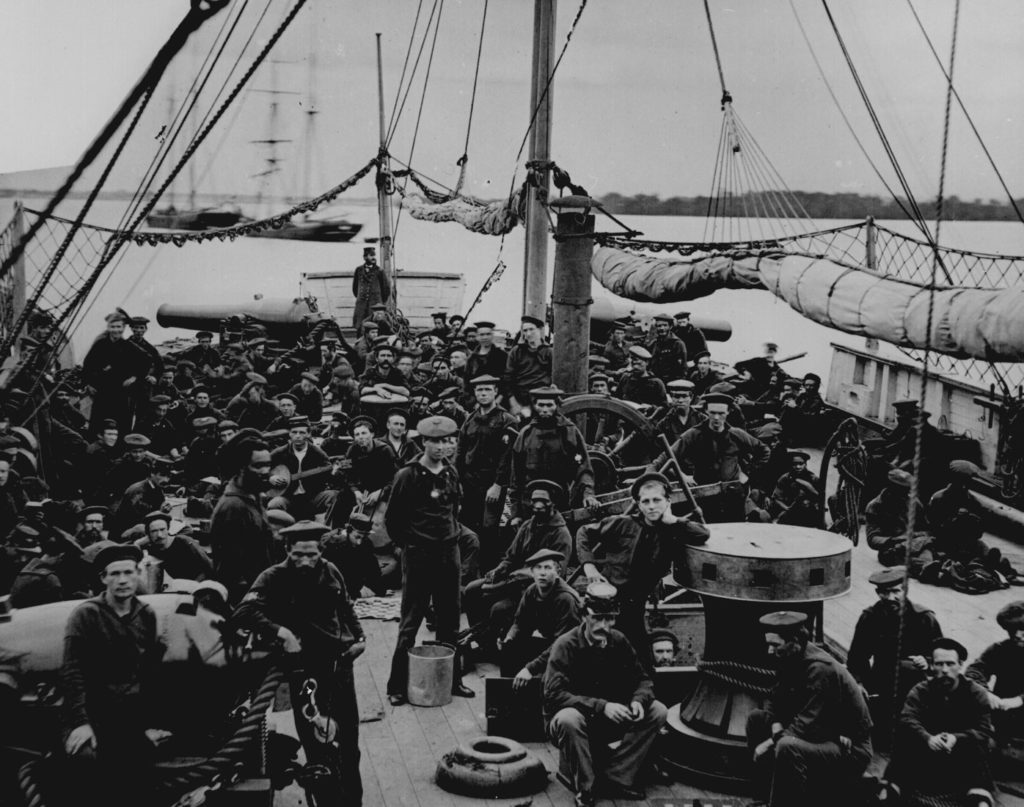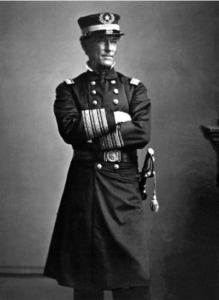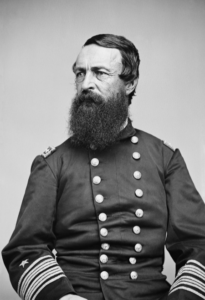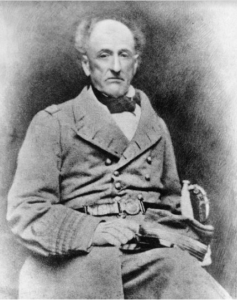
By Mike Barhorst
At the outbreak of hostilities in the Civil War, the US Navy consisted of approximately 90 ships, of which fewer than half were combat-capable. Although commercial vessels had been powered by steam for more than four decades, only twenty-six of the American naval vessels were steam-powered.
Six were frigates, including the Colorado, Niagara, Merrimac, Wabash, Minnesota, and Roanoke. Six were first-class sloops (later known as corvettes), including the Brooklyn, Hartford, Lancaster, Pensacola, and Richmond. Five were second-class sloops, including the Dakota, Iroquois, Mohican, Pawnee, and Wyoming. Two were third-class sloops, including the Narragansett and Seminole. Four were first-class side-wheel sloops, including the Mississippi, Powhattan, Saranac, and Susquehanna. Finally, there were three side-wheel steamers including the Michigan, Saginaw, and Water-Witch.
At the outbreak of hostilities, the US Navy numbered just 7,600 men of all ranks. While the sailors remained faithful to the cause of the Union, no less than 259 naval officers resigned or were dismissed, a staggering 43% of the Navy’s officer corps.
The Department of the Navy had a couple of particularly arduous and seemingly impossible tasks: 1) protect 3,600 miles of shoreline against a foe that had support from the two most powerful navies in the world at the time, England and France; and, 2) to recruit and train officers who by necessity, had to have experience and a high degree of technical training.
Lieutenant-General Winfield Scott, who had been the commanding general of the Army since 1841, presented President Abraham Lincoln with the grand strategy for the war shortly before the Battle of First Bull Run. The “Anaconda Plan” called for a blockade of Southern seaports, something the Commander in Chief knew would be impossible with a navy numbering so few ships.
Most military leaders disparaged the plan, as popular thinking held that the war would not last more than a couple of months. They knew that for the Anaconda Plan to be effective, it would take at least three years, and no one, including the President, wanted the war to last that long.
Despite the fact that Scott, who had served in the US Army since 1814, resigned November 1, 1861, Lincoln valued the plan, would refer to it often, and it ultimately became the plan that won the war. With the opening of hostilities, efforts were immediately put in place to greatly increase the size of the navy.
The war-time growth of the US Navy surprised and shocked foreign military observers. In March 1861, all commissioned ships under both steam and sail numbered 42. By July 4, 1861, the number had nearly doubled to 82. By Christmas 1861, the number of commissioned ships had grown to 264. By December 1862, the Navy had a strength of 467 ships, by December 1863, the number had grown to 588, and the following year, to 671 ships. In just four short years, the United States’ pygmy navy had become the world’s largest.
The chief architect of the growth of the US Navy was Gideon Wells, who was appointed by President Lincoln to serve as Secretary of the Navy. A New Englander, Wells was a graduate of the American Literary, Scientific, and Military Academy at Norwich, Vermont. He became an attorney, grew bored, was the founding editor of the Hartford Times, was elected to serve in the Connecticut General Assembly (1827-1835), and held a variety of positions including State Controller (1835), Postmaster of Hartford (1836-1841) and Chief of Provisions and Clothing for the US Navy (1846-1849).
A Jacksonian Democrat who held strong anti-slavery views, Wells joined the newly established Republican Party in 1854, and was the founding editor that same year of the Hartford Evening Press, a newspaper with strong Republican ties. A strong supporter of Lincoln’s candidacy, he was an obvious choice for Lincoln’s cabinet.
Lincoln referred to Wells as his “Neptune”, and charged him with carrying out the naval portion of the Anaconda Plan. Although Wells strongly disagreed with the plan, he unflinchingly carried out the President’s orders. (Fortunately, later historians have at their disposal Wells’ diary, published in three volumes in 1909).
As the Civil War was not the brief conflict that General Scott’s critics believed, the blockade of the South certainly weakened the Confederacy’s prospects. The plan, combined with the land battles that steadily eroded the South’s resources, led to the South’s defeat and the end of the Rebellion. Today, Civil War historians credit the Anaconda Plan with guiding Lincoln’s strategy throughout the war.
Perhaps the most lasting, but lesser-known contribution to the military was Wells’ introduction of the Medal of Honor for the Department of the Navy in 1861. The Department of the Army introduced their version in 1862.
Chronological Listing of Important Naval Actions of the Civil War

and admiral in the history of the United States Navy.
May 26, 1861-Attack on Aquia Batteries, Potomac River, by Commander James Harmon Ward.
June 27, 1861-Attack on Mathias Point, Potomac River; Commander Ward killed.
August 28 and 29, 1861-Capture of Forts Clark and Hatteras.
September 13, 1861-Destroying of Confederate privateer schooner Juda, by Lieutenant Charles Sawyer Russell of the United States frigate Colorado, at Pensacola Navy Yard.
October 13, 1861-Action on the Mississippi River, near Southwest Pass.
November 7, 1861-Destruction of the Confederate steamer Rusk, and capture of privateer Royal Yacht,
by Lieutenant James Edward Jouett and cutting-out party from United States frigate Santee, in Galveston Harbor.
November 9, 1861-Capture of Port Royal (Forts Walker and Beauregard), by Flag Officer Samuel Francis Du Pont.
February 6, 1862-Capture of Fort Henry, on the Tennessee River, by Mississippi Squadron, Flag
Officer Andrew Foote.
February 8, 1862-Capture of Roanoke Island, Albemarle Sound, by Commander Stephen Clegg Rowan.
February 10, 1862-Capture of Cobb’s Point Fort and Confederate gunboats, by Commander Rowan.
February 13, 1862-Capture (in co-operation with General Grant’s army) of Fort Donelson on the
Cumberland River, by Flag Officer Foote and the Mississippi Squadron.
March 9, 1862- The fight between the Monitor, commanded by US Navy Lieutenant John Lorimer Worden
and the Merrimac, commanded by Confederate States Navy Commodore Franklin Buchanan.
March 16-April 7, 1862-Bombardment and Capture of Island No. 10 by Flag Officer Foote and the
Mississippi-Squadron.
April 16-28, 1862-Capture of New Orleans and the entrance to the Mississippi, by Flag Officer David Farragut and the West Gulf Blockading Squadron.

Appointed just 21 days after his adopted brother, David Farragut, Porter served
ably until forced into retirement after powerful Members of Congress grew
concerned about his reforms of the Department of the Navy.
April 25, 1862-Capture of Fort Macon, Beaufort Harbor, North Carolina through the combined action of the US Army under Major-General Ambrose Burnside and the US Navy under the command of Commodore Charles Andrews Lockwood.
May 10-June 4, 1862-Bombardment and capture of Fort Pillow, by Captain Charles Henry Davis, successor to Flag Officer Foote, as commander of the Mississippi Squadron.
May 18, 1862-Engagement on James River; gunboats of US Navy Commander John Rodgers and Confederate battery on Drury’s Bluff.
June 6, 1862- Capture of Memphis and opening of the Mississippi River all the way to Vicksburg.
June 28, 1862-Flag Officer Farragut’s first action before Vicksburg.
August 6, 1862-Rebel ram Arkansas destroyed by Rear-Admiral David Dixon Porter before Vicksburg.
October 3, 1862-Engagement on Blackwater River, near Franklin, North Carolina by Lieutenant Charles W. Flusser, with the United States gunboats Commodore Perry, Hunchback and Whitehead.
November 16, 1862-Engagement of Confederate batteries at Columbus by gunboats Taylor and Lexington, under Commander Hanry A. Walke from Foote’s Mississippi Squadron.
November 20; 1862-Lieutenant William Barker Cushing’s adventure in New River Inlet, North Carolina; the loss of the gunboat Ellis.
December 12, 1862-Blowing up by torpedo of the U.S. ironclad gunboat Cairo commanded by Lieutenant Commander Thomas O. Selfridge in the Yazoo River.
January 1, 1863-Recapture of Galveston by the Confederates; capture of the Harriet Lane by the
Confederates; death of her captain, Commander Jonathan Mayhew Wainwright. Destruction of the USS Westfield.
January 11, 1863-Confederate privateer Alabama sinks the US gunboat Hatteras in Galveston Bay.
January 31, 1863-Naval Engagement in Charleston Harbor.
February 14, 1863-Queen of the West captured by rebels on the Red River.
February 27, 1863-Montauk destroys the Nashville on the Ogeechee River, Georgia.
March 14, 1863-Admiral Farragut passes the Port Hudson batteries on the Hartford.
March 19, 1863-Admiral Farragut passes the Grand Gulf, Mississippi batteries, and anchors below Vicksburg two days later (March 21).
March 23, 1863-Rebel ram Vicksburg is captured by Admiral Porter. The Pensacola is burned by Federal forces.
March 25, 1863-Federal ram Lancaster sinks while passing the Vicksburg batteries.
March 31, 1863-Admiral Farragut silences the Grand Gulf batteries.
April 7, 1863-Admiral Du Pont attacks Fort Sumter; the Federal monitor Keokuk is sunk; Admiral

While in the US Navy, Buchanan advocated for the creation of the US Naval
Academy, and was the academy’s first superintendent. He resigned his
commission at the outbreak of hostilities and commanded the CSS Virginia
during the war.
Farragut destroys Bayou Sarah, Louisiana.
April 16, 1863-Five gunboats and three transports run the Vicksburg batteries; the Queen of the West
is recaptured at Grand Lake. Louisiana.
April 22, 1863-Six gunboats and twelve transports, carrying the advance of Grant’s army, successfully pass the Vicksburg batteries.
April 30, 1863-Admiral Porter passes the batteries at Grand Gulf, Mississippi.
May 4, 1863-Engagement and capture of Fort De Russy, Arkansas, by Admiral Porter.
May 6, 1863-Admiral Porter’s fleet captures Alexandria, Louisiana.
May 8, 1863-Admiral Farragut commences the bombardment of Port Hudson.
May 20, 1863-Admiral Porter destroys the Yazoo City, Mississippi navy yard.
May 24, 1863-Eight rebel steamers are destroyed on the Yazoo River by a detachment of Porter’s fleet.
June 12, 1863-Tacony captured by the rebel privateer Clarence and converted into a privateer; Clarence is burned.
June 17, 1863-Rebel ram Atlanta captured.
June 19, 1863-Rebel ram Chattahoochee is blown up.
June 25, 1863-Tacony, the converted rebel privateer, captures the Archer, converts her into a privateer
and the Tacony is burned.
June 26, 1863-Converted rebel privateer Archer captured in attempted raid on Portland, Maine.
July 8, 1863- Port Hudson, Louisiana is surrendered to Major General Nathaniel Banks, thereby opening the Mississippi River.
September 8, 1863-Naval engagement in Charleston Harbor; attack on Fort Sumter repulsed.
October 5, 1863-Rebels attempt to blow up the Federal warship Ironsides.
October 31, 1863-Furious bombardment of Fort Sumter.
December 6, 1863-Monitor Weehawken sunk in a gale. Steamer Chesapeake captured by rebel
passengers.
January 12, 1864-Gunboats and transports of Admiral Porter and General William T. Sherman, on expedition up the Yazoo River, are attacked by a force of 3,000 rebels.
February 2, 1864-Rebel attack on Newberne, North Carolina is repulsed; Federal gunboat Underwriter captured and destroyed by the rebels.
February 17, 1864-Using a spar torpedo, the rebel submarine H.L Hunley sinks the Housatonic off Charleston, South Carolina.
February 28, 1864-Bombardment of Fort Powell, Mobile Harbor, by Admiral Farragut.
March 30, 1864-United States steamer Maple Leaf blown up in St. John’s River, Florida by a rebel
torpedo.
April 9, 1864-Engagement between Federal gunboats and rebels at Falls City, Louisiana; rebels are defeated with a loss of 600 killed and wounded. Rebels fail in their attempt to blow up the Federal frigate Minnesota at Kingston Roads.
April 12, 1864-Steamer Golden Gate, with U. S. Government stores, captured by rebels near Memphis.
Fort Pillow recaptured by Confederates under General Forest.
April 18, 1864-Federal gunboats Bombshell and Southfield sunk at Plymouth, North Carolina by a rebel ram.
May 1, 1864-Federal gunboat Eastport and three transports are blown up by Union forces near Alexandria, Louisiana to prevent their falling into the enemy’s hands.
May 9, 1864-Expedition of Admiral Porter and General Banks up the Red River returns and passes the
Falls near Alexandria by aid of the Bailey dams.
June 19, 1864-Sinking of the Alabama by the Kearsarge, off Cherbourg, France.
August 5, 1864- Admiral Farragut with his fleet passes Forts Morgan, Gaines and Powell in Mobile
Bay; captures Confederate Admiral Buchanan and ram Tennessee, as well as gunboat Selma; Union
monitor Tecumseh sunk by a torpedo.
August 7, 1864-Failed attempt of rebels to recapture Admiral Buchanan at Pensacola.
August 8, 1864-Fort Gaines is surrendered to United States forces, along with 874 officers and men and 26 guns.
August 23, 1864-Fort Morgan, Mobile Harbor, surrendered with all stores to United States.
October 7, 1864-Rebel privateer Florida captured by Federal steamer Wachusetts at Bahia, Brazil.
November 29, 1864-General Butler’s dispatch steamer Greyhound is destroyed by fire.
December 6, 1864-Rear Admiral John A. Dahlgren and General Robert Sanford Foster land at Pocotaligo, South Carolina and cut the Charleston Road.
December 7, 1864-Gunboat Narcissus blown up by a torpedo in Mobile Bay.
December 24, 1864- First attack on Fort Fisher by Admiral Porter and General Butler.
January 13, 1865-Second attack on Fort Fisher by Admiral Farragut and Major General Alfred H. Terry.
January 14, 1865-Capture of Pocotaligo, South Carolina.
January 15, 1865-Capture of Fort Fisher.
January 17, 1865-Loss of monitor Patapsco in Charleston Harbor.
January 18, 1865-The Harriet Lane destroyed in Havana Harbor.
January 25, 1865-The rebel ironclad Virginia blown up at the descent of the James River; other rebel
vessels are driven back.
March 4, 1865-Federal transport Thorne blown up by torpedo in the Cape Fear River.
March 19, 1865-Rebel schooner Anna Dale, in Matagorda Bay, cut loose from under two rebel batteries
and burned.
April 23, 1865-Rebel ram Webb escapes past Union fleet on the Red River; is run ashore, deserted and
blown up.
April 28, 1865-Explosion of the Federal transport Sultana, laden with soldiers, near Memphis; the lives of 1,500 wounded soldiers are lost.
June 3, 1865-Confederate Captain Jonathan H. Carter surrenders the Rebel ironclad Missouri, on the Red River to US Navy Commander W. E. Fitzhugh. The Missouri is the last Rebel ironclad to surrender.
November 6, 1865-Confederate raider Shenandoah arrives in Liverpool, England; Commander James Iredell Waddell surrenders to Royal Navy, the last Confederate contingent to surrender.
